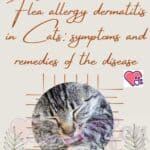
Poxvirus dermatitis in cats is the typical disease of country cats. Let’s see what the causes, symptoms and treatment are.
Poxviruses belong to the Poxiviridae family and are widespread throughout the world, where they cause disease in both humans and many other animals. The cats that are infected with this virus are, as we have previously mentioned, they are felines that live in the wild or in the countryside and therefore easily come into contact with infected prey.
In particular the red vole (Clethrionomys glareolus), the wild vole (Microtus agrestis) and the wild mouse (Apodemis sylvaticus) which are carriers of the virus and usually do not show symptoms of the disease. This infection hardly affects the house mouse, at least this is good news for the cats that live in the house and in our garden.
Cause of poxvirus dermatitis in cats
The cause, as we have been able to understand, is generated by a virus of the Poxviridae family, of the genus Orthopoxvirus. Unfortunately, it affects all cats and there is no predisposition for age, breed or sex. Instead, what has been found is that this disease affects most in autumn, even if it is not certain that it does not appear in other seasons of the year.
Furthermore, it should be noted that it is a zoonosis which means that cats can infect dogs and even humans. The way it is transmitted is through the skin, while it is more difficult to transmit through the oronasal route.
This virus tends to multiply at the puncture site, causing a primary lesion to appear which then spreads throughout the body. For this reason, the cat affected by the virus must be isolated from other animals, touched with gloves and regularly disinfected the environment in which it lives.
Symptoms
The symptoms of poxvirus dermatitis in cats appear progressively over a period of weeks, initially in fact it is a lesion due to the wound of a wild rodent, which then becomes a papule, plaque or nodule quite quickly. Later, other symptoms will appear weeks later, such as:
- 1 to 3 weeks: secondary lesions: macules, papules, nodules distributed throughout the body which then ulcerate and form crusts;
- within 3-8 weeks they disappear, but hairless scars remain;
- atypical manifestations: ulcers on the tongue and in the mouth, ulcerative stomatitis without skin lesions, edema and skin necrosis (if it happens on the fingers, there is the loss of the affected finger);
- pneumonia;
- depression;
- fever;
- widespread itching;
- conjunctivitis in cats.
However, we must remember that they are often asymptomatic, while the symptoms previously mentioned become more severe and in some cases even fatal when bacterial superinfections or FIV immunodeficiency are present in the cat.
Diagnosis and treatment of poxvirus dermatitis in cats

In order to make a diagnosis, the doctor will have to proceed with the histological evaluation of the lesions by PCR, as proceeding only with the serology will not allow to have the certainty of the pathology, but only the diagnostic suspicion.
The same goes for a differential diagnosis, i.e. excluding the various similar pathologies that can lead to an incorrect evaluation of the pathology and slow down the healing process of the animal. There is no specific cure for the treatment of poxvirus dermatitis in cats.
Once the disease has been identified, the doctor will be able to proceed with the use of antibiotics to avoid secondary bacterial superinfections, and will also be able to proceed with lysine or interferon alpha-based therapies just like with Herpesvirus.
Logically it will be the veterinarian’s care to proceed with the treatment of secondary symptoms that in any case limit the health of the cat, and then proceed with fluid therapy and strength feeding due to the ulcers present in the oral cavity.






